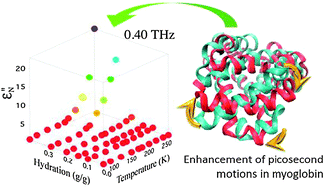Hydration and temperature interdependence of protein picosecond dynamics
Abstract
We investigate the nature of the

- This article is part of the themed collection: Ultrafast chemical dynamics
* Corresponding authors
a
IFW Dresden, Leibniz Institute for Solid State and Materials Research, D-01171 Dresden, Germany
E-mail:
f.lipps@ifw-dresden.de
Fax: +49 351 4659 313
Tel: +49 351 4659 562
b
Physics Dept. SUNY Buffalo, Buffalo, NY, USA
E-mail:
sethlevy@buffalo.edu, amarkelz@buffalo.edu
Fax: +1 7166452507
Tel: +1 7166452590
We investigate the nature of the

 Please wait while we load your content...
Something went wrong. Try again?
Please wait while we load your content...
Something went wrong. Try again?
F. Lipps, S. Levy and A. G. Markelz, Phys. Chem. Chem. Phys., 2012, 14, 6375 DOI: 10.1039/C2CP23760A
To request permission to reproduce material from this article, please go to the Copyright Clearance Center request page.
If you are an author contributing to an RSC publication, you do not need to request permission provided correct acknowledgement is given.
If you are the author of this article, you do not need to request permission to reproduce figures and diagrams provided correct acknowledgement is given. If you want to reproduce the whole article in a third-party publication (excluding your thesis/dissertation for which permission is not required) please go to the Copyright Clearance Center request page.
Read more about how to correctly acknowledge RSC content.
 Fetching data from CrossRef.
Fetching data from CrossRef.
This may take some time to load.
Loading related content
